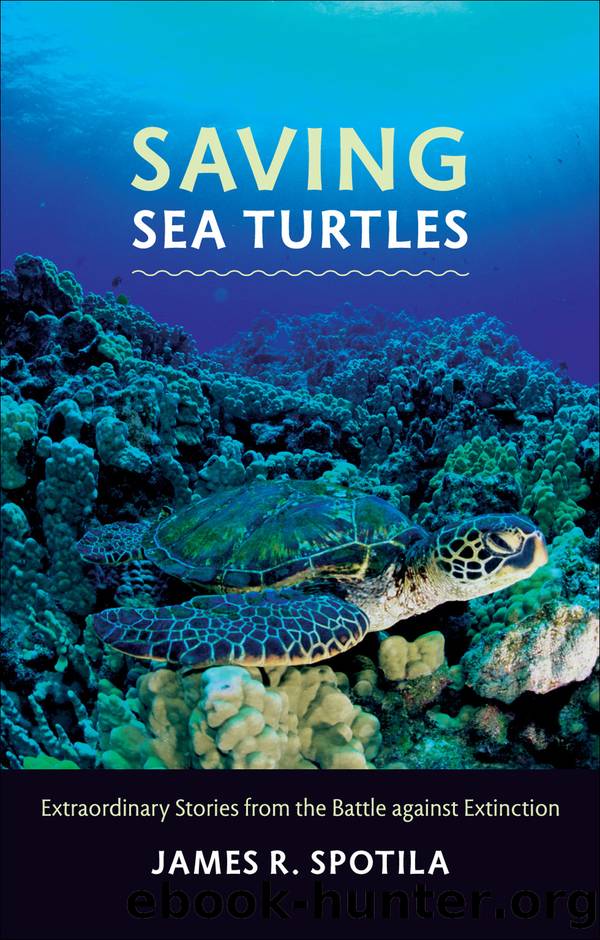Saving Sea Turtles by James R. Spotila

Author:James R. Spotila
Language: eng
Format: epub
Publisher: Johns Hopkins University Press
Published: 2011-06-15T00:00:00+00:00
Lessons Learned
When I was serving with the secretary of the Army I was impressed with a process that the Army (as well as other federal agencies) uses, called lessons learned. After every practice battle at Fort Irwin in California the enlisted soldiers and officers would gather together to determine what lessons had been learned from that exercise. In terms of what we know now about nesting beaches we can list several sea turtle lessons learned.
1. Keep the beaches natural. If a sea turtle nesting beach has not yet been developed, leave it alone. Put it into a park or a reserve of some kind and regulate use of it.
2. If a turtle nesting beach already has houses or hotels on it, stop development now. It may be necessary to grandfather-in houses that are already there and have owners par ticipate in the protection of turtles and their nests.
3. Turn off the lights. There should be no lights shining on a turtle beach. That should be pretty clear from this book. If there are houses or hotels behind a beach, be sure that they keep their lights off. As seen on Jekyll and Hilton Head islands, local lighting ordinances can be effective in keeping the beach dark for the turtles.
4. Stop the pollution. Surface and groundwater pollution in and around turtle nesting beaches will eventually be the death knell for the turtles using those beaches.
5. Stop armoring beaches. Sea walls, rock breakwalls, rock rip rap, geotextile tubes, and similar devices make beaches inaccessible to sea turtles. Face it, seas are rising (see chapter 12) and beaches are moving landward. Let them move and let sea turtles nest on them.
6. Collect the data. It is very important to keep track of the turtles and their nests to determine the long-term trends in the nesting population. Turtles are long-lived animals and their population trends have long lag times. It is necessary to track their reproductive success and population sizes for many years to determine if conservation measures are reaching their goals.
7. Never give up. One good thing about sea turtles is that there are probably large numbers of juveniles in the ocean pipeline. So even if things look bleak on the nesting beach, keep up the effort, and in a few years hopefully you will see the fruit of your efforts.
Download
This site does not store any files on its server. We only index and link to content provided by other sites. Please contact the content providers to delete copyright contents if any and email us, we'll remove relevant links or contents immediately.
| Amphibians | Animal Behavior & Communication |
| Animal Psychology | Ichthyology |
| Invertebrates | Mammals |
| Ornithology | Primatology |
| Reptiles |
Sapiens: A Brief History of Humankind by Yuval Noah Harari(14258)
The Tidewater Tales by John Barth(12610)
Mastermind: How to Think Like Sherlock Holmes by Maria Konnikova(7236)
Do No Harm Stories of Life, Death and Brain Surgery by Henry Marsh(6891)
The Thirst by Nesbo Jo(6838)
Why We Sleep: Unlocking the Power of Sleep and Dreams by Matthew Walker(6620)
Life 3.0: Being Human in the Age of Artificial Intelligence by Tegmark Max(5480)
Sapiens by Yuval Noah Harari(5298)
The Longevity Diet by Valter Longo(5021)
The Body: A Guide for Occupants by Bill Bryson(4979)
The Rules Do Not Apply by Ariel Levy(4870)
The Immortal Life of Henrietta Lacks by Rebecca Skloot(4529)
Animal Frequency by Melissa Alvarez(4400)
Why We Sleep by Matthew Walker(4366)
The Hacking of the American Mind by Robert H. Lustig(4319)
Yoga Anatomy by Kaminoff Leslie(4310)
All Creatures Great and Small by James Herriot(4239)
Double Down (Diary of a Wimpy Kid Book 11) by Jeff Kinney(4210)
Embedded Programming with Modern C++ Cookbook by Igor Viarheichyk(4112)
